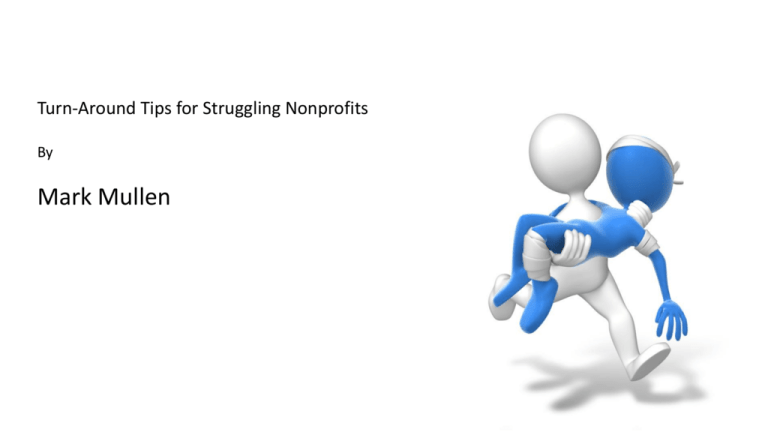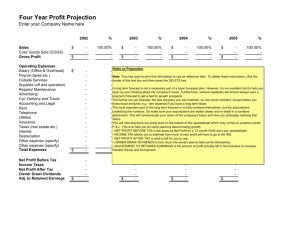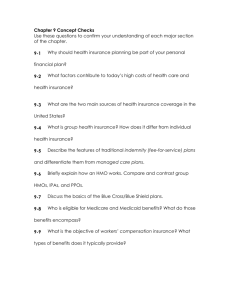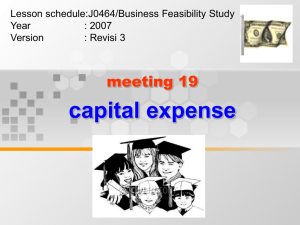How to Build a Strategic Nonprofit
advertisement

Turn-Around Tips for Struggling Nonprofits By Mark Mullen 1. Understand why the organizations exists • Revisit, reexamine, refine the mission • List as succinctly as possible the societal problem your organization is trying to solve • List all programs that deliver on mission • Rate (from 1 to 10) each program on mission importance. In other words, which programs are critical to the mission and which ones are marginally essential. • Create graph showing five year user participation for each program 2. Understand the financial reports (part I) • Create Statement of Financial Activities report that compares FY previous to FY current with projected year-end variance to budget • Create Statement of Financial Activities report that compares month-to-month FY previous to FY current with monthly projected budget variances • Create Statement of Financial Activities for each program - including sponsorship, grant, and donor contributions - that compares FY previous to FY current 2. Understand the financial reports (part II) • Create Cash Flow report projecting cash flow for each month of the FY • How many days can the organization operate if no additional revenue was received before required to borrow? (see Cash Ratio on next slide) • Create Line of Credit report showing monthto-month draw and month-to month debt repayment • Create an Investment report showing five year annual gains • Create graph showing five year comparison of total organizational revenue vs expenses Some Helpful Financial Ratios Ratio Debt Ratio Ratio Equation Total Debt / Total Assets Shows proportion of debt to assets. Higher values means greater liquidity problems Quick Ratio Current Assets / Current Liabilities Measures ability to meet short-term obligations with liquid assets Savings Ratio Revenue – Expense / Total Expense Measures increase or decrease in the ability of the nonprofit to increase net assets Cash Ratio Step 1: Annual Expense Budget / 365 = One Day Cash Usage Step 2: Cash + Investments / One Day Cash Usage Measures the number of days nonprofit could operate if no additional funding was received Program Expense Ratio Program Expense / Total Expense Measures relationship of funds spent on programs with all expenses Ratio Target 1 or less Greater than 1 is too high 1 to 1.9 Under 1 is too low Over 2 is too high Ratios greater than 1 show increase in savings 180 days or higher Less than 90 days is too low 65% or higher Under 65 is too low Your Ratio 3. Understand the organization’s business model • Use newly created Statements of Financial Activities to rate (from 1 to 10) each program on revenue generation • Use newly created Statements of Financial Activities to rate (from 1 to 10) each program on expense usage • Use ratings for mission importance, revenue generation, and expense and rate in priority order the programs that have highest mission and revenue values (revenue must be at break-even or profit generating) 4. Understand your user community • Conduct brief user benefit audit to determine which services/products are delivering value in the minds of the users • Is your user community growing, shrinking, stable? • Is your organization user friendly? • What keeps your users engaged with your organization? 5. MAKE TOUGH DECISIONS • Deliver only those programs that are highly mission related and produce positive revenue • Eliminate programs that are marginally related to the mission, especially if they break even or lose revenue. (If a marginal program breaks even it still uses resources that could be allocated to highly related to mission programs.) • Reducing programs will reduce expenses and, most likely staff. (Employee compensation is the biggest expense for any organization.) 6. Understand the organization’s talent pool & skills • If you must reduce staff do not automatically eliminate positions from discontinued programs. A recent Gallup Poll shows that 70% of all workers are not actively engaged with the mission of their employer. You want to make sure you keep the 30% who are actively engaged. • Do not fall into the trap of keeping mediocre but loyal employees over high-maintenance high-performing employees. You need the high performers with the proper skill sets to turn the organization around. Without them, the organization will contain to struggle leaving all employees at risk of unemployment. Communicate (broadly to all shareholders changes in programing as result of turn around): • Role clarity – who is accountable for each program; who participates in decision-making • Often – reassure, welcome & answer questions, build confidence in organization • Honestly with transparency – build trust • In positive light – things will get better; the organization will get stronger • In many formats – emails, social media, newsletters, phone calls, meetings Adapted from Book: How to Build a Strategic Nonprofit: A Guide to Getting the Right Things Done by Mark Mullen ISBN - 10: 1501066889 ISBN – 13: 978-1501066887 http://www.amazon.com/dp/B00ND5XCVI Kindle Edition





